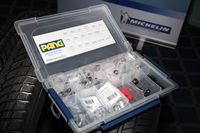Words of wisdom from Michelin regarding tyre pressure monitoring

Dave Crinson, the Head of Fleet at Michelin, has issued a warning to all drivers against becoming too complacent with their tyre pressures in the wake of the introduction of TPMS; Tyre Pressure Monitoring Systems. This electronic safety device, that became a mandatory inclusion in November 2012 on all newly homologated cars, effectively monitors pressure inside the tyres and if the pressure drops under a certain pressure, usually 20% under flated, it alerts the drivers that this has happened.
Michelin have welcomed this new European legislation that has introduced this device to both help to improve road safety and also reduce a cars CO2 emission, but Mr Crinson is keen to point out that as good as TPMS is, it should not be seen as an alternative to regularly checking your tyres.
Crinson said: “TPMS is an excellent development for the motoring industry and the fact it is now a compulsory feature of all new cars is an extremely positive step. Any technology that helps reduce the number of motorists who drive on under-inflated tyres, and therefore reduces the number of accidents on the road, should be embraced by the industry.
“However, although TPMS is an excellent tool, there is the possibility it could encourage drivers to act only when the alarm is raised and not to carry out basic checks regularly, which are so important. TPMS will only detect a reduction in tyre pressure so it’s essential that drivers continue to regularly check tread depths and look for any damage, including penetrating objects such as nails and screws.
“We all have warning lights to show when our vehicle’s oil is low or to indicate there is a problem with the engine, but we still regularly check oil levels and have our vehicle serviced – it’s the same with tyre pressures and TPMS.”
Michelin advises that tyre pressures should be checked at least once a month and before long journeys, however results from its regular Fill Up With Air events indicate a high number of drivers are neglecting their tyres.
Tests on a total of 3,722 vehicles in 2012 revealed that 30 per cent of drivers had tyre pressures classed as ‘dangerous’ – between 8 and 14 psi under-inflated, and nine per cent of pressures were classed as ‘very dangerous’ – more than 14 psi below their vehicle’s recommended level. Only 28 per cent of vehicles tested were found to have the correct pressures as recommended by the vehicle manufacturer.
Although TPMS has been available since the 1980s, new regulations state that from November 2012 all newly homologated cars need TPMS as standard fitment, and in November 2014 TPMS will be required on all newly manufactured cars.